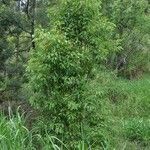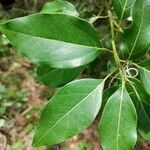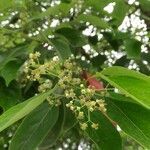Tree to 20 m high. Stem sometimes buttressed. Twigs ± terete, glabrous. Leaves alternate or pseudowhorled; petiole 2–4 cm long; lamina ovate to very broadly ovate or elliptic, 4–11 cm long, 2.5–6 cm wide, usually triveined at base, glaucous below. Inflorescence usually slightly shorter than leaves. Flowers opening widely with tepals becoming ± horizontal, white or cream, smelling of camphor. Tepals 1–2 mm long, c. 1 mm wide, pubescent on inner surface at least in lower half. Anthers c. 0.5 mm long; filaments c. 0.7 m mm long; filaments and staminodes pubescent. Ovary to 1 mm long, to 1 mm wide, glabrous; style glabrous; stigma funnel-shaped. Fruit globose, to 10 mm diam., black; cup apex entire.
Trees , to 15 m. Branches terete, glabrous, terminal and axillary buds covered by imbricate bracts, young twigs with clusters of scars from fallen bracts. Leaves alternate; petiole to 3 cm. Leaf blade ovate to elliptic or elliptic-lanceolate, with (1-)3 primary veins, 7-12 × 3-5 cm, base rounded to cuneate, apex sharply acute; surfaces glabrous except for pubescent domatia in axils of main lateral veins. Flowers: tepals greenish white, 1-2 mm, glabrous abaxially, pubescent adaxially; stamens arranged in outer whorl of 6 (actually 2 whorls of 3) and inner whorl of 3. Drupe to 9 mm diam. 2 n = 24.
A tree. It grows to 36 m high. It keeps its leaves throughout the year. It has a rounded crown 15 m wide. The trunk is short with scaly, grey bark. The trunk can be 3 m across. The whole plant has a strong camphor smell. The bark is yellow brown with cracks along it. The leaves are alternate. The leaves are pink when young. They turn green with age. The leaf stalk is slender. The leaf blade is 6-12 cm long by 2.5-5.5 cm wide. The flower cluster is in the axils of leaves. Flowers are green-white or yellow. The fruit are round. They are greyish-black.
Much-branched tree 6-12 m. tall.. Leaves alternate, ovate to ovate-elliptic, 5-11 cm. long, 2-6 cm. wide, acuminate at the apex, cuneate at the base with glands in the axils of the primary nerves.. Flowers small, yellow or white in panicles.. Fruit small, black, fleshy.











